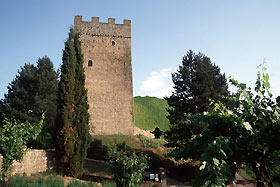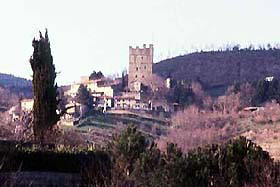Porciano Castle
The
Porciano Castle dominates a hill far about a kilometer from the
river Arno and at the same distance from Stia. Stia is reachable with
the SS.70 Umbro-Casentinese following the indications.
 |
| The Keep with a line of the survived
curtain walls. |
The historical memories about Porciano goes back to the
11th century, the castle is named on a year's 1017 document as residence
of the Count Guido di Teudegrimo, founder of the branch of the counts
Guidi from Porciano, so we can consider it as one of the first settlements
of the powerful Casentinese family. More than two centuries after, in
the year 1288, was the famous Count Tegrimo that, here retired after
the Campaldino battle, attacked and stole the unlucky wayfarers and merchants
that passed in the proximity's of the castle. Of his 'noble art' exists
testimony in a 1291 sentence against the Count: he have to pay 10.000
gold florins to the Podesta (medieval term for chief magistrate or governor)
of Florence to have stolen at a merchant of Ancona. The successor
of Tegrimo was the Count Guido Alberto of Porciano, also condemned by
the Florentine Republic to have plotted in a conspiracy to upset the same
one. In March 20th 1349 the castle passed under the dominion of Florence,
having the last Count of Porciano, Ludovico, suit the monk's abit abandoning
all his terrestrial richness.
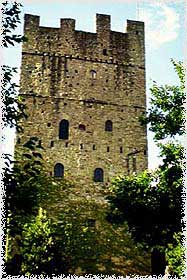 |
| The greatest surviving keep in the
whole Casentino. |
As to many other places of this area also on Porciano
exist a lot of memories, even if you don't historically proved, regarding
the great poet Dante Alighieri. The legend says that in year 1311 Dante
was brought for the first time in Porciano to convince the Counts
of the Guidi family, that opposed for a long time the Florentine Guelphs,
to support the just crowned Emperor Arrigo VII and to convince him to
take openly side with the Ghibelline cause. From Porciano departed two
famous letters written by the poet. The first one, March 31st 1311, destined
to the Florentine, full of resentment and hate after the exile to which
he was condemned, with the purpose to invite them to submit to the emperor.
The second, the 16th April of the same year, to the emperor to push him
to crush with the weapons the same Florence. But the Counts Guidi didn't
keep the promises of fidelity done to the Emperor, and the poet immortalized
his contempt for the traitors in the XIV� chant of the Purgatory of the
'Divine Comedy'. This caused the revenge of the Guidi family that imprisoned
the Alighieri in one of the halls of Porciano. Another legend that concerns
the castle is related to the presence between its walls of a treasure,
a gold bell that 'it is worth how much the whole Casentino'.
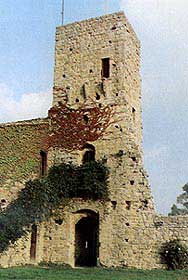 |
| The western tower. |
The mighty Keep of Porciano, still gifted of battlement,
is the greatest of the whole Casentino with its 35 meters and six plans
of height. It is raised between the rests of the fortified walled enclosure,
two towers, the western transformed in bell tower of the church of the
little town and two gates, one to north and another to south. The downfall
of the castle began in the 16th century in contemporary with the growth
of the town of Stia, placed at the bottom of the valley, much more comfortable
for the commerce. The ruins of the fortification also knew the shame to
be destined to agricultural use. As the near castle of Romena,
also Porciano became in the 19th century ownership of the Counts of the
Goretti d� Flamini family that took care of its restoration. On the site
were also done archaeological researches that have allowed to reconstruct
the phases of development of the castle. It's now possible to see the
complex system of canalization of the waters that were served to flow
from the roof of the keep to the principal cistern sited in the court
of the castle and in a small misure inside the same tower for drinkable
use. After the last works, finished in 1978, the ruins results well kept
and today have been opened to the public, the tower also entertains an
apartment, residence of the owners, and a small museum of the things recovered
in the area.
Looking today at this castle of small dimensions can
seem impossible that in the Middle Age its importance was so notable.
The 'court' of Porciano was frequented by knights, noble and ambassadors,
the deriving merchants from the east had to pass under the walls of this
castle to approach towards Florence and an Emperor confided in its alliance
to subdue the powerful Florentine Dominion.
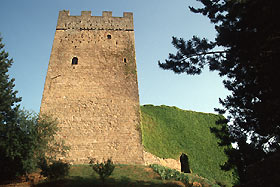 |
 |
| The best preserved side of the walls
with the keep and the north gate. |
The south gate. |
|
